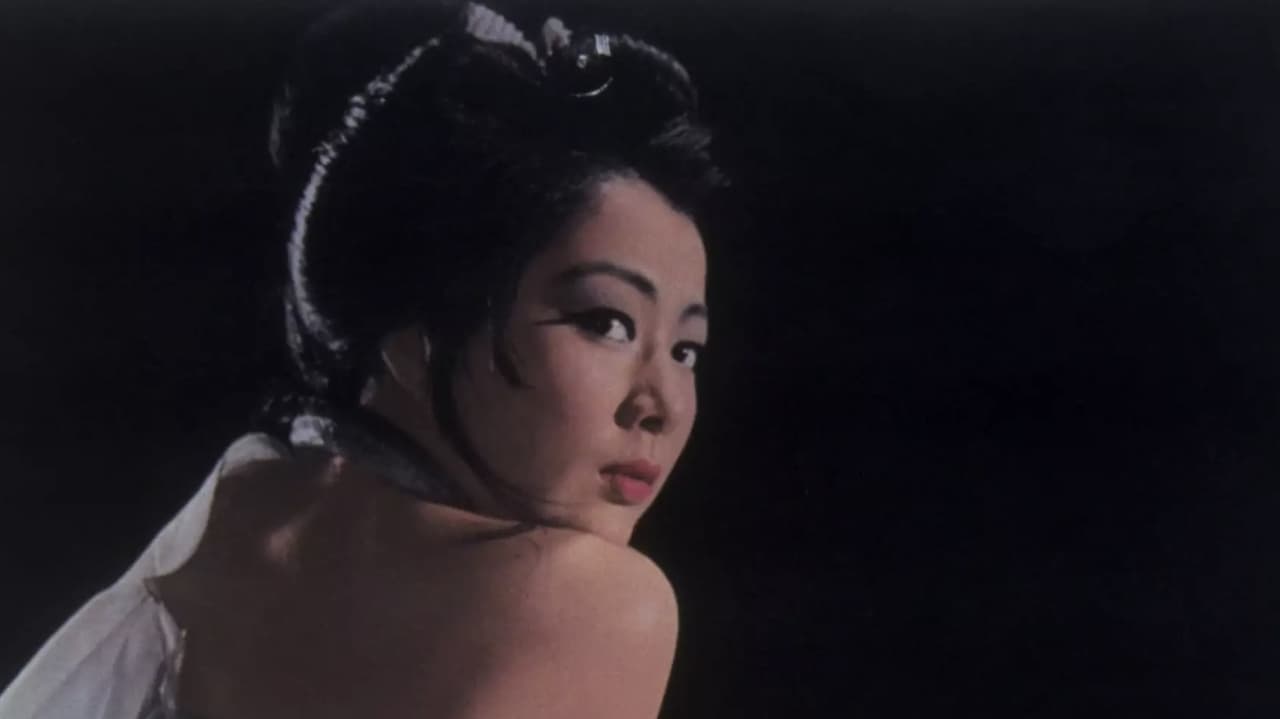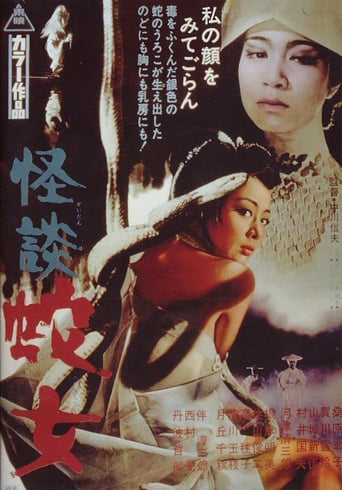

All of these films share one commonality, that being a kind of emotional center that humanizes a cast of monsters.
... View MoreThe tone of this movie is interesting -- the stakes are both dramatic and high, but it's balanced with a lot of fun, tongue and cheek dialogue.
... View MoreThis is a dark and sometimes deeply uncomfortable drama
... View MoreWorth seeing just to witness how winsome it is.
... View MoreThis haunting, beautiful, and atmospheric Japanese ghost story is set in the days of feudal Japan and tells of an evil rich family making life miserable for farmers working their land. When one farmer dies, his wife Sue (Chiaki Tsukioka) and daughter Asa (Yukiko Kuwahara) are made to work for domineering landlord Cyobei Onuma (Seizaburo Kawazu). Unspeakable tragedies befall this family, who just can't seem to catch a break. Poor Asa is continuously harassed by Onumas' sleazy son Takeo (Shingo Yamashiro), for one thing. During this period in history, it was considered an unwise move to kill a snake, and when the landlord & family have a serpent killed on their premises, it sort of kick starts a slow but steady turn in their fortunes."Snake Woman's Curse" is powerfully affecting, especially when one thinks of the misfortune that comes Asas' way. One just can't help but take some great pity on her and her parents. Even though one worker named Sutematsu (Kunio Murai) feels compassion for Asa, and swears that he will marry her, he doesn't always see things her way. When Takeo goes after her, Sutematsu is disgusted that she didn't try harder to fend off his advances and maybe kill him in the attempt. Screenwriter Fumio Konami & screenwriter / director Nobuo Nakagawa certainly build up quite a deal of contempt for our heartless antagonists.He also commendably plays this *just* right. Although there is a sufficient amount of grotesque imagery and makeup effects to add to various hallucinations, it's also quite possible that what the Onuma family experience is all in their heads, and that guilt is catching up with them. The compelling nature of the melancholy scenario is supplemented by that breathtaking scenery and widescreen photography. Also, Konami & Nakagawa take the trouble to balance some of the grief of the story with some well timed, and not excessive, comedy. Kameshichi, played by Shunji Sayama, is our principal comic relief character and he does a pretty amusing job.With lovely music by Shunsuke Kikuchi as accompaniment, "Snake Woman's Curse" manages to be an effectively eerie (if never all-out scary) shocker that also establishes a certain sympathy for the slithering cast members. The finale and resolution are quite memorable.Seven out of 10.
... View MoreThe closest parable I can think of to the 60's boom of ghost stories, what is called kaidan in Japan, is the Roger Corman films based on Poe; unsophisticated but competent setups, in these films usually about karmic retribution for anomie, and a final third of horror visualized with some flair and ostentation. It's always this last part that is worth watching, with the first just the solid groundwork.As with the Corman/Poe films, some of these largely identical films are just more satisfying than others. This is one of those middling affairs and what is to blame, I think, is that it just came out when this cycle was already obsolete and about to be eclipsed from the second end of a double-bill by the new fashion of yakuza and chambara films.The '59 version of Ghost of Yotsuya by the same filmmaker one could even say it was fresh, aesthetically vibrant, even though the staged illusions were adopted directly from kabuki; by '68 it was tired material film-wise.Shiro Toyoda's films are interesting counterpoints from this time, when the kaidan film was on its way out; knowing how repetitive these had been, Toyoda reworked conventions into more personal portraits of madness. I suggest you seek those out instead.
... View MoreAnd you thought that you had a lousy landlord! Just take a look at what mother Sue and daughter Asa have to put up with, in veteran director Nobuo Nakagawa's 1968 offering, "Snake Woman's Curse." After their husband/father has been worked to death by landlord Onuma, in the village of Onuma on the shores of northern Japan at the beginning of the Meiji Period (around 1868), the two women are compelled to work in the master's house, weaving for 16 hours a day, performing other slavelike labor, and knuckling under to the occasional sexual attack by Takeo, the "young master." Fortunately, when these two poor women reach their physical limits and expire, their vengeance has just begun, as their spirits come back to seek a playful and haunting revenge on Onuma and his entire family. Beautifully shot and skillfully produced, "Snake Woman's Curse," though never at all frightening, still manages to please. Featuring gorgeous seaside locations and an abundance of attention to period detail, the film is great to look at, and pretty Sachiko Kuwahara is quite appealing and touching as the downtrodden Asa. After two viewings, I'm still a trifle unclear as to who the snake woman of the title is--Sue or Asa--and truth to tell, many incidents in the film go largely unexplained. The picture ultimately winds up feeling like a Japanese fable conflated with one of those old EC comics; the ones in which the spirits of the disgruntled dead take a grisly vengeance on their living malefactors. And I suppose being forced to see your new bride covered with scaly snake skin on your wedding night is a pretty good vengeance for starters, right? From first shot to its memorable final image (the spirits of the dead walking toward a rising sun), the film manages to keep the viewer focused and guessing. In all, a modestly entertaining picture that will most likely please horror fans who are game for something different....
... View MoreThe first 45 minutes or so of director Nobuo Nakagawa's "Snake Woman's Curse" displays the tragic circumstances of a small family's hardships under the tyrannical power of cruel landlord, his equally nasty wife Masae, and their wicked son, "young master" Takeo. A sickly elderly farmer, Yasuke, desperately wishes to pay of his debt for a small portion of land, and later dies after futilely attempting to persuade the landowner to give him more time. Yasuke's gentle wife and daughter, Sue and Asa, are left without a place to live, and are forced into hard labor under the ferocious iron hand of Masae, who immediately responds towards them with aggression and menace. Even the smallest mistake or miscue, and the women are dealt with the harshest punishment allowed. Takeo takes a shine to Asa, raping her multiple times, without any sense of regret or guilt over such actions. Even worse, Takeo knew of Asa's desire to marry local farmer, Sutematsu, and took her virginity so that they couldn't marry under the proper terms. It doesn't get any better for Asa, because her dear, innocent mother, Sue, dies when the landlord strikes her during an attempt to stop her master from killing a snake she was trying to save. Facing continual cruelty from Masae and not being able to see a possible bright future with Sutematsu, Asa will take her own life. Sutematsu, enraged, will seek revenge against Takeo, fated to end up such like the kind peasant family he loved so dear.The later portion of the film shows the Ônuma family falling prey to the ghosts of the three they wronged. The apparitions of Yasuke, Sue & Asa often appear to the Ônuma trio as a reminder of their roles in their tragic deaths. The symbolic theme throughout is the appearance of snakes and hallucinations of scales showing up on people's bodies, a method used to torment the Ônumas. The ghosts appear out of the blue, snakes popping up in bowls, out of the air, crawling throughout the rooms..the Ônumas are now the subject of cruelty, attempting to rid themselves of the ghosts that haunt them and unable to do so. Are the ghosts really there or are the Ônumas merely falling prey to their own demons, their own guilt? Takeo is tormented by the memory of Asa, her pleading against his sexual abuse ringing in his mind. The landlord tormented by Yasuke's begging to keep his property, even promising to eat dirt if necessary. Masae constantly plagued by the images of snakes, her actions towards Sue(..who always wished to protect snakes when others wished to kill them)returning to terrorize her mental state. The film is quite black and white. The Ônumas are vile, unsympathetic monsters, who work their hired help day and night. Always barking and commanding, often never at ease with those who doggedly seek their approval. Yasuke's family, quiet, meek, soft-hearted, and hard-working. They just wish to work for their land and earn their keep. Their plight at the hands of the Ônumas is undeserved and ruthless. The film presents the ghosts in white face paint, a light introducing them to us and the Ônumas who are besieged by them. The score is eerily effective presenting a disorienting nature to the scenes where the ghosts appear to the Ônumas. The film presents the hierarchy as unlikable cretins who deserve the terror released upon them at the end, while the peasant workers slave, sweat, and work their fingers to the bone without much support/appreciation from those that rule over them. Director Nobuo Nakagawa's film isn't subtle(..neither was his more famous work, Hell(Jigoku))and loudly proclaims it's disdain for the mistreatment of the poor by the rich so many might be critical(..as they were with Jigoku)of such a one-sided presentation. The good lower class trampled under the cruel boot of the evil wealthy, a theme that is preached from the pulpit of Nobuo Nakagawa without restraint..sure to turn off a few who would rather the director paint a more complex portrait. I didn't mind the theatricality of it all and rooted my heart out for the bastards of this film getting their just desserts.
... View More